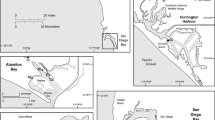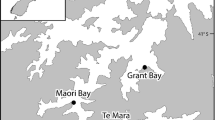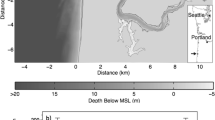Abstract
Oyster restoration practitioners augment habitat with hard substrata to increase oyster recruitment, but success can be complicated by non-indigenous species recruitment and physical processes such as sedimentation. From June 2012 to June 2014, we examined changes in shell cover and recruitment of native Ostrea lurida and non-indigenous, global invader Crassostrea gigas onto a constructed oyster bed in Alamitos Bay, CA, USA relative to an un-augmented control mudflat. Due to 72% shell loss after 1 year and informed by a concurrent study on elevational distributions of both oyster species, we augmented the oyster bed with additional shell on the lower-elevation, seaward side. One year later, O. lurida densities were significantly greater on the lower-elevation bed relative to the control and 19.4 times greater than reference populations throughout Alamitos Bay. Crassostrea gigas recruited in densities equivalent to reference populations. Adaptively restoring the bed via shell additions at a lower elevation achieved higher shell retention, increased O. lurida densities, and increased the ratio of native versus non-indigenous oysters. Our increased understanding about the role of tidal elevation in targeted restoration success of a native relative to a non-indigenous oyster species will inform future restoration designs.




Similar content being viewed by others
Data Availability
Applicable international, national and institutional guidelines for care and use of animals were followed. Oysters collected were permitted via a California Department of Fish and Wildlife Scientific Collecting Permit to Zacherl. Data are available upon request.
References
Baker P (1995) Review of ecology and fishery of the Olympia oyster, Ostrea lurida, with annotated bibliography. Journal of Shellfish Research 14:501–518
Beck MW, Brumbaugh RD, Airoldi L, Carranza A, Coen LD, Crawford C, Defeo O, Edgar GJ, Hancock B, Kay MC, Lenihan HS, Luckenbach MW, Toropova CL, Zhang G, Guo X (2011) Oyster reefs at risk and recommendations for conservation, restoration, and management. Bioscience 61:107–116
Bonnot P (1935) The California oyster industry. California Fish & Game 21:65–80
Boyer K, Zabin C, de la Cruz S, Grosholz E, Orr M, Lowe J et al (2016) In: Bilkovic D, Mitchell M, La Peyre M, Toft J (eds) Living shorelines: the science and management of nature-based coastal protectionSan Francisco Bay living shorelines: restoring eelgrass and Olympia oysters for habitat and shoreline protection. CRC Press, Boca Raton
Briley SK (2015) Response of eelgrass (Zostera marina) to an adjacent Olympia oyster restoration project. California State University, Fullerton
Brumbaugh RD, Coen LD (2009) Contemporary approached for small-scale oyster reef restoration to address substrate versus recruitment limitation: a review and comments relevant for the Olympia oyster, Ostrea lurida Carpenter 1864. Journal of Shellfish Research 28:147–161
Brumbaugh RD, Beck MW, Coen L (2006) A practitioners’ guide to the design and monitoring of shellfish restoration projects:an ecosystem services approach. The Nature Conservancy Arlington, VA., MRD Educational Report No. 22 p 28
Buhle ER, Ruesink JL (2009) Impacts of invasive oyster drills on Olympia oyster (Ostrea lurida Carpenter 1864) recovery in Willapa Bay, Washington, United States. Journal of Shellfish Research 28:87–96
Camara MD, Vadopalas B (2009) Genetic aspects of restoring Olympia oysters and other native bivalves: balancing the need for action, good intentions, and the risks of making things worse. Journal of Shellfish Research 28:121–145
Champieux TM (2015) Impacts of a constructed oyster bed on infaunal invertebrate communities in Jack Dunster Marine Reserve. California State University, Long Beach
Coen LD, Luckenbach MW, Breitburg DL (1999) The role of oyster reefs as essential fish habitat: a review of current knowledge and some new perspectives. American Fisheries Society Symposium 22:438–454
Cohen AN, Harris LH, Bingham BL, Carlton JT, Chapman JW, Lambert CC, Lambert G, Ljubenkov JC, Murray SN, Rao LC, Reardon K, Schwindt E (2005) Rapid assessment survey for exotic organisms in southern California bays and harbors, and abundance in port and non-port areas. Biological Invasions 7:995–1002
Crooks JA, Crooks KR, Crooks AJ (2015) Observations of the non-native Pacific oyster (Crassostrea gigas) in San Diego County, California. California Fish & Game 101:101–107
Dahl TE, Johnson CE, Frayer WE (1991) Wetlands, status and trends in the conterminous United States mid-1970's to mid-1980’s. U.S. Fish and Wildlife Service
Dinamani P (1991) The Pacific oyster, Crassostrea gigas (Thunberg, 1793), in New Zealand estuarine and marine bivalve mollusk culture. CRC Press, Inc, Boca Raton
Dinnel PA, Peabody B, Peter-Contesse T (2009) Rebuilding Olympia oysters, Ostrea lurida Carpenter 1864, in Fidalgo Bay, Washington. Journal of Shellfish Research 28:79–85
Fasten N (1931) The Yaquina oyster beds of Oregon. American Naturalist 65:434–468
Furuse K, Furota T (1985) An ecological study on the distribution of intertidal sessile animals in inner Tokyo Bay. Marine Fouling 5:1–6
Gilbert CH (1889) Report on certain investigations regarding the planting of oysters in Southern California; Alamitos Bay and Newport Bay, California. U S Fish Comm Bull 9:95–97
Gillespie GE (2009) Status of the Olympia oyster, Ostrea lurida Carpenter 1864, in British Columbia, Canada. Journal of Shellfish Research 28:59–68
Grabowski JH, Hughes R, Kimbro DL, Dolan MA (2005) How habitat setting influences restored oyster reef communities. Ecology 86:1926–1935
Hopkins AE, Galtsoff PS, McMillin HC (1931) Effects of pulp mill pollution on oysters. US Government Printing Office
Jacobsen R (2009) The living shore: rediscovering a lost world. Bloomsbury Publishing USA
Kirby MX (2004) Fishing down the coast: historical expansion and collapse of oyster fisheries along continental margins. Proceedings of the National Academy of Sciences of the United States of America 101:13096–13099
Krassoi FR, Brown KR, Bishop MJ, Kelaher BP, Summerhayes S (2008) Condition-specific competition allows coexistence of competitively superior exotic oysters with native oysters. Journal of Animal Ecology 77:5–15
La Peyre M, Furlong J, Brown LA, Piazza BP, Brown K (2014) Oyster reef restoration in the northern Gulf of Mexico: extent, methods and outcomes. Ocean and Coastal Management 89:20–28
Lotze HK, Lenihan HS, Bourque BJ, Bradbury RH, Cooke RG, Kay MC, Kidwell SM, Kirby MX, Peterson CH, Jackson JB (2006) Depletion, degradation, and recovery potential of estuaries and coastal seas. Science 312:1806–1809
Mann R, Powell E (2007) Why oyster restoration goals in the Chesapeake Bay are not and probably cannot be achieved. Journal of Shellfish Research 26:905–917
McGraw KA (2009) The Olympia oyster, Ostrea lurida Carpenter 1864 along the west coast of North America. Journal of Shellfish Research 28:5–10
Meyer DL, Townsend EC, Thayer GW (1997) Stabilization and erosion control value of oyster cultch for intertidal marsh. Restoration Ecology 5:93–99
Nestlerode JA, Luckenbach MW, O’Beirn FX (2007) Settlement and survival of the oyster Crassostrea virginica on created oyster reef habitats in Chesapeake Bay. Restoration Ecology 15:273–283
Newell RIE, Koch EW (2004) Modeling seagrass density and distribution in response to changes in turbidity stemming from bivalve filtration and seagrass sediment stabilization. Estuaries 27:793–806
O'Beirn F, Luckenbach M, Nestlerode J, Coates G (2000) Toward design criteria in constructed oyster reefs: oyster recruitment as a function of substrate type and tidal height. Journal of Shellfish Research 19:387–395
Polson MP, Zacherl DC (2009) Geographic distribution and intertidal population status for the Olympia oyster, Ostrea lurida Carpenter 1864, from Alaska to Baja. Journal of Shellfish Research 28:69–77
Polson MP, Hewson WE, Eernisse DJ, Baker PK, Zacherl DC (2009) You say conchaphila, I say lurida: molecular evidence for restricting the Olympia oyster (Ostrea lurida Carpenter 1864) to temperate western North America. Journal of Shellfish Research 28:11–21
Powers SP, Peterson CH, Grabowski JH, Lenihan HS (2009) Success of constructed oyster reefs in no-harvest sanctuaries: implications for restoration. Marine Ecology Progress Series 389:159–170
Pritchard C, Shanks A, Rimler R, Oates M, Rumrill S (2015) The Olympia oyster Ostrea lurida: recent advances in natural history, ecology, and restoration. Journal of Shellfish Research 34(2):259–271
Raith M (2013) Phylogeny and species diversity of Gulf of California oysters (Ostreidae) inferred from mitochondrial DNA. Master thesis, California State University Fullerton, Fullerton, CA
Ridge JT, Rodriguez AB, Fodrie FJ (2017) Salt marsh and fringing oyster reef transgression in a shallow temperate estuary: implications for restoration, conservation and blue carbon. Estuaries and Coasts 40:1013–1027
Schulte DM, Burke RP, Lipcius RN (2009) Unprecedented restoration of a native oyster metapopulation. Science 325:1124–1128
Scyphers SB, Powers SP, Heck KL Jr, Byron D (2011) Oyster reefs as natural breakwaters mitigate shoreline loss and facilitate fisheries. PLoS One 6:e22396
Seale EM, Zacherl DC (2009) Seasonal settlement of Olympia oyster larvae, Ostrea lurida Carpenter 1864 and its relationship to seawater temperature in two southern California estuaries. Journal of Shellfish Research 28:113–120
Shaw WN (1997) The shellfish industry of California-past, present and future. In: NOAA (ed) Book 128
Tidal-Influence (2012) Conservation and management plan: Colorado lagoon western arm natural area. Friends of Colorado Lagoon, http://www.tidalinfluence.com/uploads/1/6/2/7/16274920/coloradolagoonmanagementplanfinalprez.pdf
Tronske NB, Parker TA, Henderson HD, Burnaford JL, Zacherl DC (2018) Densities and zonation patterns of native and non-indigenous oysters in Southern California bays. Wetlands 38:1–14. https://doi.org/10.1007/s13157-018-1055-0
Walles B, Fodrie FJ, Nieuwhof S, Jewell OJ, Herman PM, Ysebaert T (2016) Guidelines for evaluating performance of oyster habitat restoration should include tidal emersion: reply to Baggett et al. Restoration Ecology 24:4–7
Wasson K (2010) Informing Olympia oyster restoration: evaluation of factors that limit populations in a California estuary. Wetlands 30:449–459
Wasson K, Zabin C, Bible J, Briley S, Ceballos E, Chang A, Cheng B, Deck A, Grosholz T, Helms A, Latta M, Yednock B, Zacherl D, Ferner M (2015) A guide to Olympia oyster restoration and conservation: environmental conditions and sites that support sustainable populations. Elkhorn Slough National Estuarine Research Reserve, JT Litho
Wasson K, Hughes BB, Berriman JS, Chang AL, Deck AK, Dinnel PA, Endris C, Espinoza M, Dudas S, Ferner MC, Grosholz ED (2016) Coast-wide recruitment dynamics of Olympia oysters reveal limited synchrony and multiple predictors of failure. Ecology 97:3503–3516
White J, Buhle ER, Ruesink JL, Trimble AC (2009a) Evaluation of Olympia oyster (Ostrea lurida Carpenter 1864) status and restoration techniques in Puget Sound, Washington, United States. Journal of Shellfish Research 28:107–112
White J, Ruesink JL, Trimble AC (2009b) The nearly forgotten oyster: Ostrea lurida Carpenter 1864 (Olympia oyster) history and management in Washington state. Aquaculture 28:43–49
Zabin CJ, Wasson K, Fork S (2016) Restoration of native oysters in a highly invaded estuary. Biological Conservation 202:78–87
Zacherl DC, Moreno A, Crossen S (2015) Exploring restoration methods for the Olympia oyster, Ostrea lurida Carpenter, 1864: effects of shell bed thickness and shell deployment methods on shell cover, oyster recruitment, and oyster density. Journal of Shellfish Research 34:819–830
Zedler JB (2017) What’s new in adaptive management and restoration of coasts and estuaries? Estuaries and Coasts 40:1–21
Zu Ermgassen PS, Spalding MD, Blake B, Coen LD, Dumbauld B, Geiger S, Grabowski JH, Grizzle R, Luckenbach M, McGraw K, Rodney W (2012) Historical ecology with real numbers: past and present extent and biomass of an imperiled estuarine habitat. Proceedings of the Royal Society B 279:3393–3400
Acknowledgements
Thanks to the agencies who helped us secure permits and permissions: California Coastal Commission, City of Long Beach, California Regional Water Quality Control Board, California Department of Fish and Wildlife, United States Fish and Wildlife Service, and the Army Corps of Engineers. Thanks to collaborators Orange County Coastkeeper and KZO Education, Lenny Arkinstall for site access and logistical support, Kelly Donovan for graphics, and our hardworking community volunteers and students. Carlsbad Aquafarm provided discounted shell, arranged for shell inspection, and facilitated shell transport. Dennis Peterson provided invaluable advice. Two anonymous reviewers provided thoughtful comments that greatly improved the quality of the manuscript. Funds were provided to Zacherl by NOAA Restoration Center, California State Coastal Conservancy (Project No. 11-058-01), California State University Fullerton Department of Biological Science, CSU Fullerton Senior Intramural Award, Zucchero Management Incorporated, and The CSU Council on Ocean Affairs, Science and Technology.
Author information
Authors and Affiliations
Corresponding author
Ethics declarations
Conflict of Interest
We complied with all ethical standards and declare no conflict of interest. Applicable international, national and institutional guidelines for care and use of animals were followed. Oysters collected were permitted via a California Department of Fish and Wildlife Scientific Collecting Permit to Zacherl.
Additional information
Publisher’s Note
Springer Nature remains neutral with regard to jurisdictional claims in published maps and institutional affiliations.
Rights and permissions
About this article
Cite this article
Fuentes, C.M., Whitcraft, C.R. & Zacherl, D.C. Adaptive Restoration Reveals Potential Effect of Tidal Elevation on Oyster Restoration Outcomes. Wetlands 40, 93–99 (2020). https://doi.org/10.1007/s13157-019-01166-7
Received:
Accepted:
Published:
Issue Date:
DOI: https://doi.org/10.1007/s13157-019-01166-7




